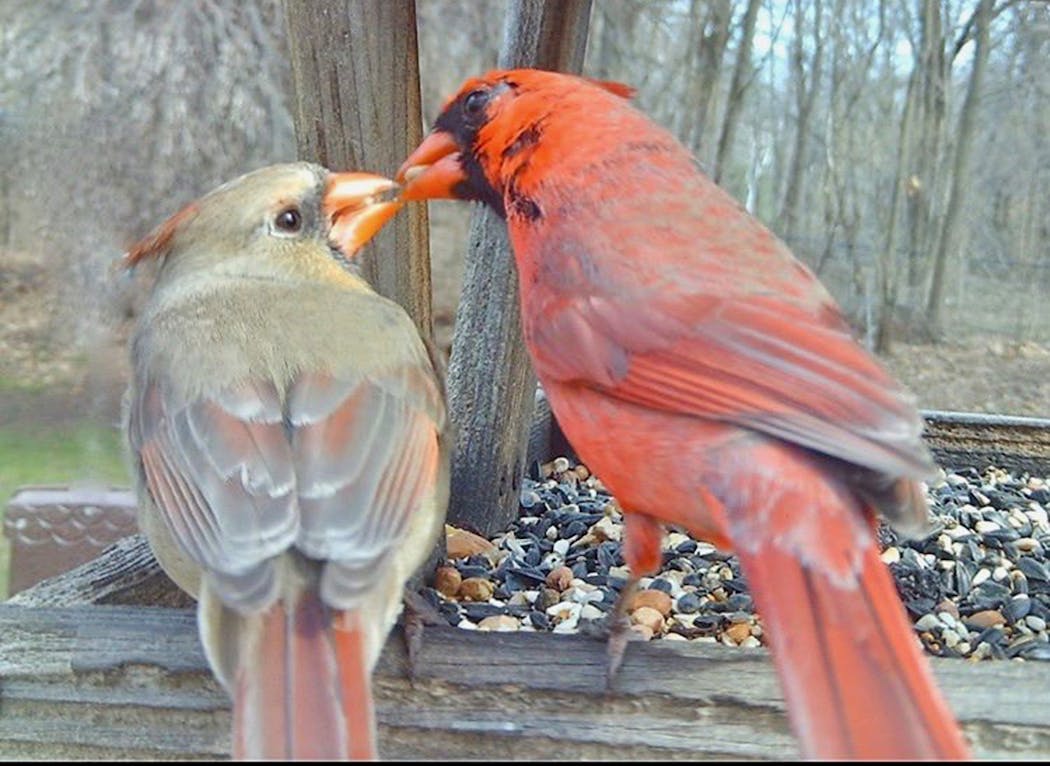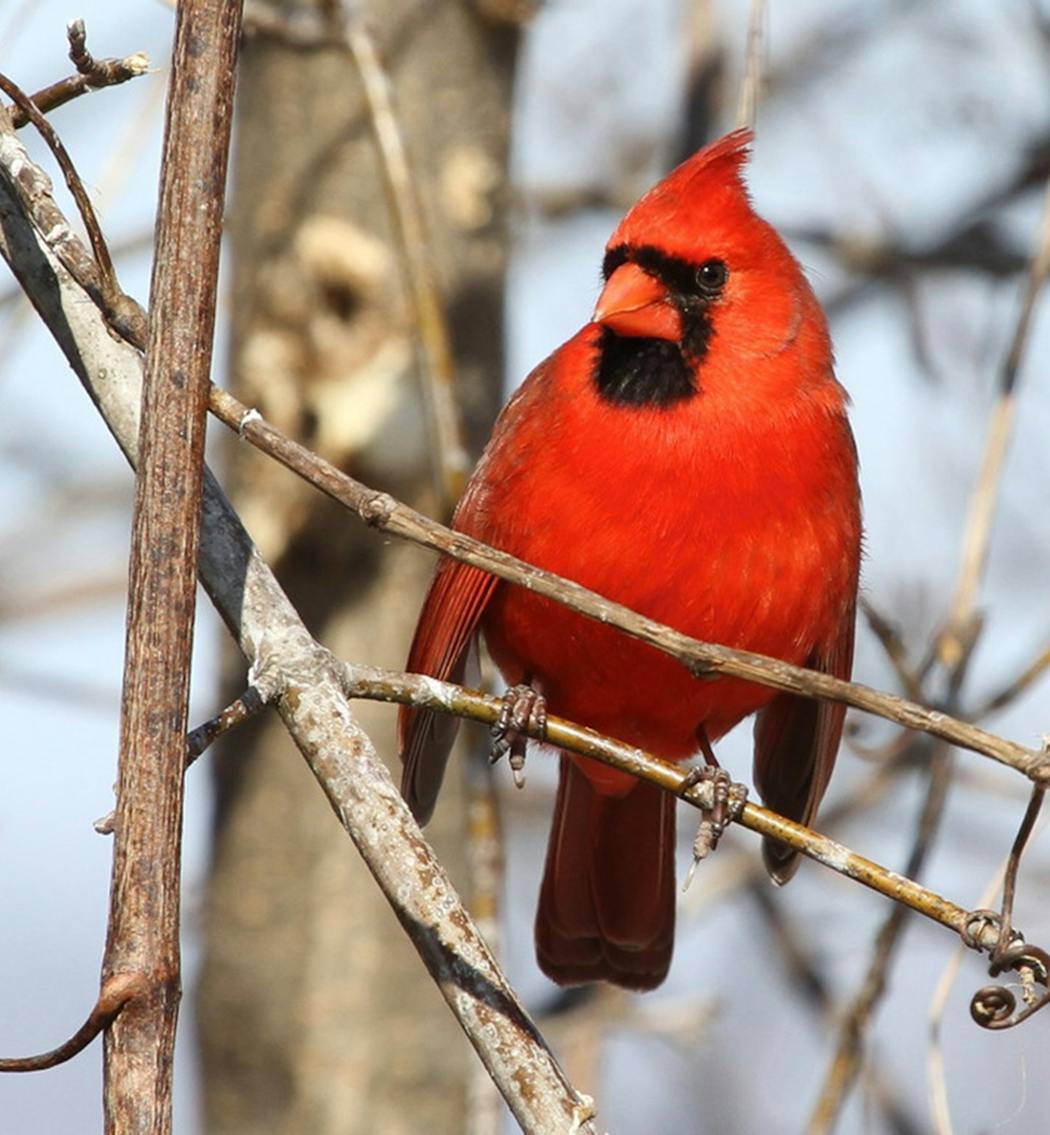The longer winter goes on, with its monochrome palette, leafless branches and profound silence, the more we appreciate the brilliantly red Northern cardinal.
Cardinals visit our backyards and feeders every month of the year, but in winter they seem to be in nature's spotlight. Unlike many songbirds, they combine brilliant plumage with a melodious song (with many other birds, it's one or the other). There's nothing quite like the sight of brilliant red birds fluttering down to feeders or the snow under them on a winter evening.
Winter's near silence is broken, starting as early as January, by cardinals' thrilling songs issuing from treetops and utility wires. Both genders sing, and a male and female will engage in "birdy, birdy, birdy," and "wha-cheer-cheer-cheer" duets, filling the neighborhood with sound as they firm up their bond before nesting season.
It was only about 100 years ago that cardinals began appearing in our area. Despite being named the Northern cardinal, they'd been birds of the South. But as environmental conditions changed, they began to push northward. According to the Cornell Lab of Ornithology, two things fueled their northward expansion: more people — at least 50 million of us — are maintaining bird feeders, and more of us are adding home landscaping, especially shrubs. Cardinals love shrubs, spending part of each day sheltering inside bare branches and, come spring, building their cup nests deep within the shrubbery.
Warmer nights brought on by climate change are also a factor in their northward push. Cardinals don't do well in prolonged cold, apparently preferring areas where the average minimum January temperature is at least 5 degrees F.
Males and females are strikingly different in looks, even though both get their red coloration from the seeds and berries they eat. Their genes determine how that pigment gets distributed, and redness is an important factor in the cardinal world. A bright red male is perceived by females as in excellent condition, thus a good potential mate (at least in rural areas, more about this later). The subtler plumage of the female cardinal allows her to avoid the eyes of predators while she sits on her nest.
As one reader recently wrote, "I've come to appreciate the elegant beauty of the female Northern cardinal. Her hues are vibrant, artfully arranged and accent her buff coloring perfectly."
Here are some tales from other readers about one of our favorite backyard birds:
"One summer I watched a male cardinal fluttering between my deck bench and the utility wires above it. I realized he was trying to snatch a big spider in the center of its web, but wasn't being successful. So he flew up and nipped one of the web's supporting threads and hovered again, but that didn't work, so he nipped another, but still no luck. Finally, he flew up and nipped a third supporting thread, the web collapsed, the spider fell to the sidewalk and the cardinal got his lunch!" – Karen Eckman
"Both the male and female are real lookers, which is not true for a lot of bird species where a male and female have different plumage. I've been noticing 12 cardinals at a time at my feeders in the daytime this winter. And I was really happy that four pairs arrived while I was doing my first Great Backyard Bird Count, in February." – Craig Millard
"One summer we were able to watch a family of cardinals nest in the lilac outside our dining room windows. They've often nested in our lilacs, and once in our brambly rose bush. Another summer, we delayed the installation of our tall fence along the alley until the cardinals were done with their nest in the rose bush." – Sharon Shinomiya
"I was surprised to see Northern cardinals when we visited Hawaii last February. It fascinates me how they can survive winter in northern Minnesota at temperatures of -36F but also live comfortably in tropical climates like Hawaii. Now that's an adaptable bird." – Beth Siverhus
These stories point up how smart and resilient these beautiful birds are.
And they hint at how much we treasure these handsome red birds that add spirit and verve to a winter's day.
St. Paul resident Val Cunningham, who volunteers with the St. Paul Audubon Society and writes about nature for local, regional and national newspapers and magazines, can be reached at valwrites@comcast.net.
Less fit in town
Cornell Lab of Ornithology researchers analyzed feathers from many cardinals and found that the birds' brightness was a good indicator of a bird's overall health and fitness. However, city cardinals eat a lot of berries from honeysuckle plants, an alien species. These birds were very brightly colored but weren't in as good condition as their country cousins, because honeysuckle berries are low in fat and protein. So urban cardinals' redness isn't as good a health indicator for female cardinals.
Keep cardinals red
Some good choices for plantings that appeal to cardinals:
They're fans of just about any kind of berry, including those from pagoda dogwood and dogwood shrubs, viburnum shrubs, elderberry shrubs, winterberry shrubs, wild grape, blackberry plants, mulberry, serviceberry and hackberry trees and staghorn sumac.




